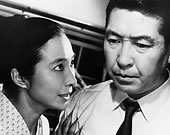監督:成瀬巳喜男 1966 102分 東宝
出演:小林桂樹、珠玉美千代
「視線を横顔で受け止める小林桂樹」
すさまじい交通量の幹線道路沿いの歩道に、男がひとり佇む、その後ろ姿を捉えつつこの映画は幕を開ける。つづいて男は、清潔だが陰鬱な雰囲気のビアホールに入り、一人生ビールを飲む。ガラス窓をトントンとたたく音。透明の幕越しに、彼の親友が見える。彼は中に入ってよいか?とゼスチャーをし、ジョッキを握る男は静かに頷く。親友が、ウェイトレスに「おなじものを」と注文する言葉が聞こえるまで、一言たりとも台詞は聞こえず、影を意識的に多く取り込み、暗部が強調されたその画面の息詰まるような黒は、この作品のトーンを決定的なものとしている。
ものの2分の導入シーンだが、殺人者である主人公の提示、無声映画的な人物のインターアクション、豊かな影を配した暗い画面により、経済的に説話の中心を示し、同時にその先に見える暗い未来、何かただならぬ事態が起こり、その中心にこの人物が絡んでいるのではないか、という予感をぼんやりと感じさせる高度な演出。
誰がサスペンスの主人公であるのか、それをカメラでド正面で捕らえ、わかりやすく「見せる」のは簡単なこと。しかし、何も包み隠さず提出するワイラー的な語りよりも、ニコラス・レイの「In A Lonely Place (孤独な場所で)」のごとく、男の後ろ姿と横顔の暗さを盗み見てゆく、そんなアプローチを成瀬が選んだことがおもしろい。生前エドワード・ヤンがこの作品を見たか否かは知らぬが、彼ならこの画面の漆黒に熱狂するのではないだろうか。
珠玉美千代が突き刺すような視線で夫・小林桂樹を見つめ、夫は決して妻の素顔を見返すことなく、あくまでも横顔でその凝視を受け止め続ける。そう、小林桂樹は他人の視線を、常に横顔で受け止め続ける特異な存在であり、思い出せば冒頭の導入でも、ビールを飲む彼の真横から親友が不意に登場したのであった。この点においても、成瀬は映画のトーンを冒頭の2分で提示しているといえる。畏るべき集中力。
そして、小林桂樹の横顔に視線を突き刺し続ける珠玉美千代が、夫を正面から見つめたとき、今まで蓄積してきた影の漆黒が、殺しとして画面に結晶化する。説話上、側に控えているだけの印象であった妻・珠玉美千代が、だまし船のように、ラスト映画の中心に立っているのは、この視線の転換と殺しによるものに違いない。
“The Stranger Within a Woman” Mikio Naruse 1966 102 minutes
The film starts with the back of a man walking along a noisy major street in Tokyo.
Then he sits alone in a dark beer hall drinking draft beer. Suddenly a knock is hard on the glass window. We see his best friend thru the glass gesturing, “can I join you?” The man nods and the friend enters the hall ordering a waitress, “same one as his.” Until we hear his voice ordering there are no dialogs, yet Naruse’s mise-en-secne is amazingly smooth and economical in storytelling. His silent-film-based interactions and the rich black tone of B&W photography set up the simple and beautiful trajectory to the dark mystery. It is rather like the dark & mysterious ambiguity of Nicholas Ray than like the straight-forward clarity of William Wyler.
I thought Keiju Kobayashi was amazingly unique in a way that he always receives the gaze of his wife, Michiyo Aratama, on his profile and doesn’t look back at her. The camera beautifully composes their never-crossing gaze in 4:3 standard frame. At the climax when their gaze finally meet and the couple face each other, Aratama makes up her mind to carry out her ultimatum: poisoning her husband. It is quite interesting that the focus of the story shirts then from husband to wife almost unknowingly — this is, I think, because we’ve been always watching the profile of Kobayashi and the straight-forward gaze of Aratama on camera. So we unconsciously synchronies our gaze with Aratama’s looking at her mysterious husband. Am I making sense?
女の中にいる他人 "The Stranger Within a Woman"

